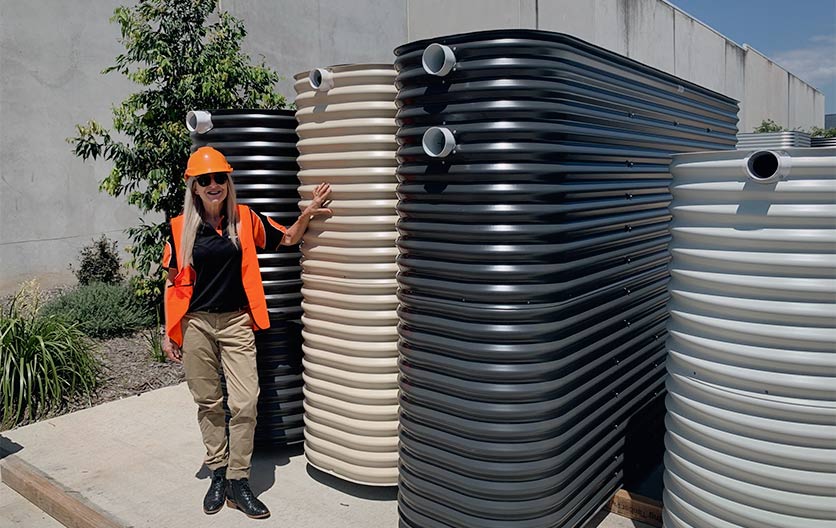Slimline Water Tanks: Fashionable and Practical for Modern Residences
Slimline Water Tanks: Fashionable and Practical for Modern Residences
Blog Article
Discovering the Various Uses Rain Containers for Residential and Commercial Features
As the international emphasis on lasting living methods continues to escalate, the usage of rain storage tanks in both domestic and commercial setups has actually arised as an essential remedy. These storage tanks provide a tank for rain harvesting, presenting a myriad of prospective applications that expand much beyond mere storage. From watering to commode flushing and landscaping, the flexibility of rainwater storage tanks is substantial. Moreover, their combination into industrial residential or commercial properties opens up a world of opportunities for eco conscious companies. The complex uses rain containers offer an engaging instance for their fostering, not just as a functional water-saving action yet additionally as a testimony to liable source administration.
Benefits of Using Rainwater Containers
Making use of rain storage tanks uses various advantages for both homes and neighborhoods in terms of water conservation and sustainability. One of the essential advantages of utilizing rainwater tanks is the substantial decrease in reliance on mains water - Slimline water tanks. By recording and storing rainwater for later use, individuals and areas can lower their need for cured water, eventually reducing the worry on water therapy facilities and lowering power usage related to water transport and treatment
Furthermore, rainwater harvesting with tanks gives a reputable alternate water source during times of water constraints or shortages. This kept rainwater can be used for various non-potable objectives such as watering, flushing commodes, and washing clothing, lowering the stress on typical water sources. Furthermore, utilizing rain tanks can result in set you back financial savings for both households and neighborhoods by reducing water costs and decreasing the need for expensive framework developments to meet growing water demands.
Fundamentally, the application of rainwater storage tanks uses a lasting and eco-friendly technique to water monitoring, profiting both individual customers and the more comprehensive area in terms of water preservation, cost-efficiency, and strength.
Rainwater Tank Use in Watering
Offered the advantages of rain containers in preserving water sources and lowering dependence on keys water, a significant application depends on making use of saved rain for watering functions - Slimline water tanks. Rain gathering systems can properly accumulate and keep rainwater, offering a sustainable water source for sprinkling yards, yards, and agricultural fields. By using rain for watering, homeowner can reduce their dependancy on cured water sources, resulting in cost financial savings and ecological benefits

One of the key advantages of making use of rainwater for watering is its pureness. Rainwater is normally soft and without the chemicals and ingredients typically located in mains water, making it suitable for beneficial plants without the risk of dangerous effects. Furthermore, rain goes to ambient temperature, which can benefit plant development by avoiding temperature level shocks that can take place with chilly keys water.
Rain Storage Tanks for Commode Flushing

Carrying out rainwater containers for bathroom flushing is a cost-efficient and eco friendly practice that can be quickly integrated right into both domestic and business residential properties. The stored rain can be used to purge toilets by attaching the tank to the existing pipes system. This simple yet reliable solution find out here now can dramatically reduce water intake in a building, specifically in areas where water deficiency is an issue.

Including Rain Storage Tanks in Landscaping
These containers can record and save rainwater drainage from roof coverings, which can after that be utilized for watering yards, yards, and plants. By utilizing rainwater for watering functions, home owners can reduce their dependence on local water sources, leading to set you back financial savings and conservation of precious water sources.
In addition to offering a sustainable water resource for landscape design requirements, rainwater containers can also aid in handling stormwater runoff. By catching rainwater that would certainly otherwise stream into tornado drains, these containers can minimize disintegration, decrease flooding risks, and protect against contamination of all-natural water bodies. Including rain tanks in landscaping can contribute to the general aesthetic charm of the building, showcasing a dedication to environmental stewardship.
Commercial Applications of Rainwater Tanks
Using rainwater storage tanks in industrial settings uses a lasting remedy redirected here for water monitoring and preservation, profiting organizations and the environment alike. Commercial applications of rainwater containers vary and increasingly preferred as a result of the cost savings and environmental advantages they provide. One essential industrial usage is for watering objectives, where collected rainwater can be used to water landscape design, yards, and farming fields surrounding commercial buildings. This can bring about substantial decreases in water expenses and reliance on community water resources.
Additionally, rainwater accumulated in tanks can be dealt with and used for non-potable objectives within business buildings, such as flushing commodes, cleansing, and cooling systems. On the whole, the consolidation of rainwater containers in commercial setups presents a functional and environmentally accountable method to water administration.
Conclusion
In conclusion, rainwater tanks provide various benefits for both property and business homes. From watering to commode flushing and landscape design, using rain containers can aid preserve water sources and lower water costs. In addition, including rain containers in industrial settings can result in considerable expense savings and environmental advantages. On the whole, the versatility and sustainability of rainwater containers make them a beneficial financial investment for any type of homeowner aiming to raise water performance.
Report this page